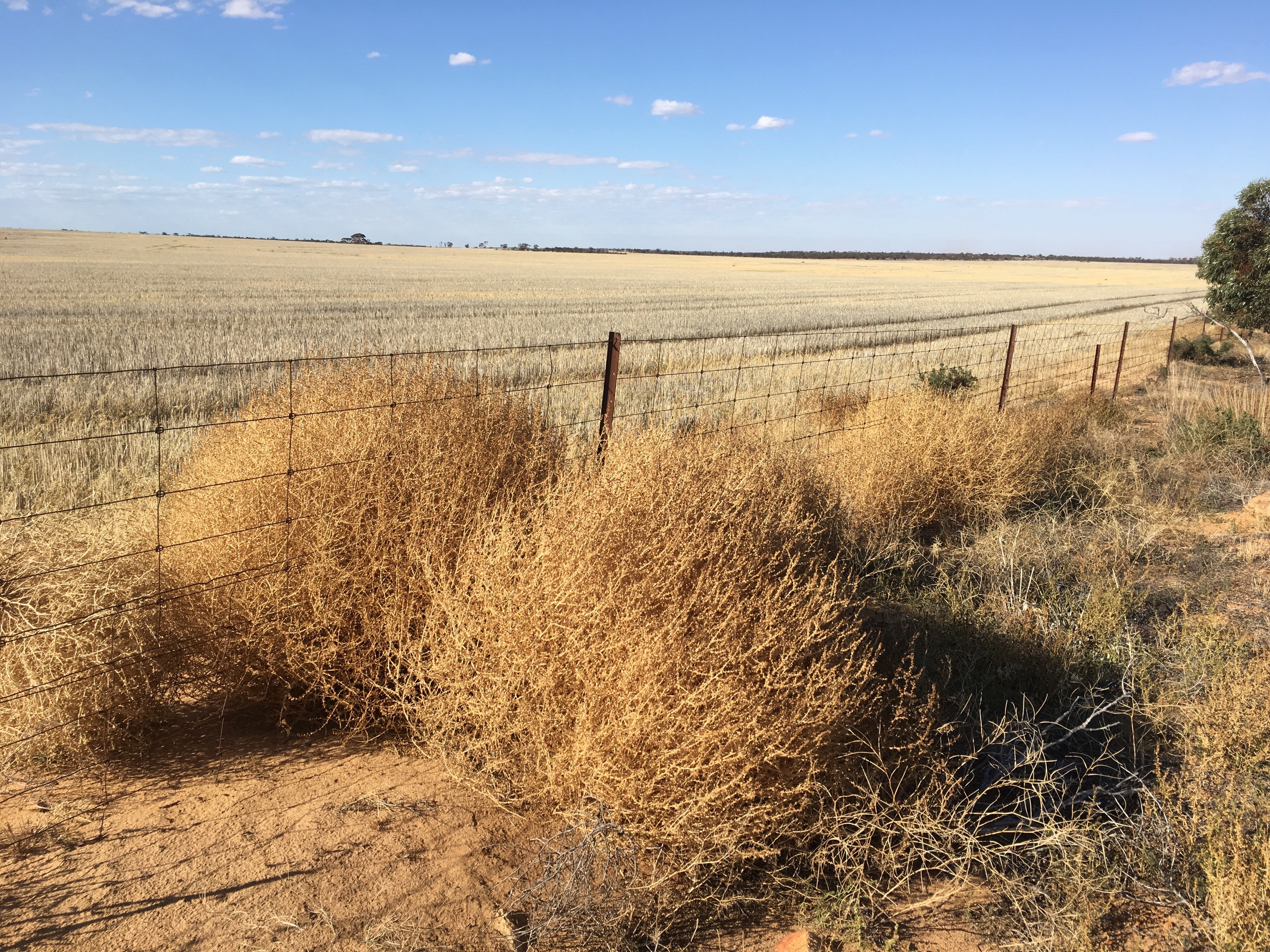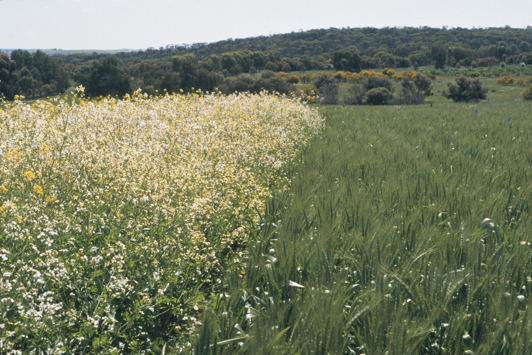The department conducts research into the management of weeds and has developed varied weed control options, including chemical, physical, and biological strategies that are vital for sustainable weed management in Western Australia (WA). Weed populations that have developed herbicide resistance, where standard herbicide treatments are no longer effective, pose an increasing threat to WA's agricultural production.
Management of crop weed
Integrated weed management tactics
Understanding the most serious and competitive crop weeds and the methods to control them helps reduce costs and improve productivity.
Integrated weed management (IWM) packages for these weeds incorporate control options including chemical, physical, and biological strategies that are vital for sustainable weed management.
This page links to information about the most serious and costly weeds of annual winter cropping systems in Western Australia’s grainbelt:
Effective strategic and tactical options are available to manage weed competition (which can causes losses costing around $1 billion per annum) that will increase crop yields and profitability.
Weeds with herbicide resistance are an increasing problem in grain cropping enterprises. Integrated weed management (IWM) is a system for managing weeds over the long term and is particularly useful for managing and minimising herbicide resistance.
Growers are advised to adopt integrated weed management (IWM) to reduce the damage caused by herbicide-resistant weeds.
Herbicide resistant weed populations are found throughout all cropping areas of Western Australia. The number of resistant species and areas affected by resistance continues to increase. By understanding the implications and evolutionary processes of herbicide resistance, appropriate weed management strategies can be devised that will minimise the impact and delay the development of further resistance.
Develop an integrated weed management plan
An integrated weed management plan uses several tactics to control each target weed.
Integrating tactics and herbicide mode-of-action (MOA) groups will reduce weed numbers, stop replenishment of the seedbank, and minimise the risk of developing herbicide resistant weeds.
Basic agronomy and fine-tuning of the crop system are important steps towards weed management.
Tactics
Each tactic provides a key opportunity for weed control and depends on the management objectives and stage of growth for target weed.
Integrating tactics results in reduced weed numbers, prevents replenishment of the seedbank, and minimises the risk of developing herbicide-resistant weeds.
Integrated weed management plan tactics include:
- Agronomic practices to enhance weed management
- Are you planting resistant weeds with your crop seed?
- Assess weed population density
- Control small weeds in crops
- Control the green bridge for pest and disease management
- Manage crop weeds at harvest
- Managing crop weeds
- Reduce crop weed seed numbers in the soil
- Stop crop weed seed set
Each integrated weed management plan should be based on the following steps:
- Review past actions - the history of herbicide use should be considered to prioritise weed management tactics to avoid the use of high-risk herbicide mode-of-action groups and identify paddocks at risk (where weed populations can be prioritised for resistance testing)
- Assess the current weed status - see the pages, Herbicide resistance, and Assess weed population density
- Identify weed management opportunities in the cropping system - ensure the proposed changes are suited to the land, infrastructure, and resources, and the tactics are environmentally and economically sound
- Match opportunities and weeds with suitable effective tactics
- Combine ideas using a rotational planner that is drafted for each paddock and includes details such as key weeds, soil type, soil pH, resistance issues, crop and pasture rotations, selected weed management tactics, and herbicide use

Summer weeds and their management
Summer weeds can rob subsequent crops of soil nitrogen and stored soil water and reduce crop emergence by causing physical and/or chemical interference at seeding time.
Achieving timely control of summer weeds can result in tangible benefits through increases in crop yield and/or quality and speed up the sowing operation.
Moderate to heavy uncontrolled weed growth can result in reduced crop emergence in minimum tillage systems due to the impenetrable layer left on the soil surface. Wireweed, for example, has long tough and wiry stems which can get caught in the tynes at seeding.
Some weeds are allelopathic, where toxic substances are released directly from plant’s roots, or during the decomposition of their residue. These toxic substances can inhibit the subsequent germination of the crop. In a study by the Cooperative Research Centre (CRC) for Australian Weed Management, allelopathic weeds (such as caltrop) reduced subsequent wheat emergence by as much as 25% due to the chemicals that were exuded from the roots.
Controlling summer weeds early will conserve valuable soil nitrogen and moisture for use by the crop during the following season.
The adoption of consistent summer weed control in the Western Australian (WA) grainbelt by a Salmon Gums farmer has demonstrated an average farm crop yield increase of 400 kilograms per hectare (kg/ha).
The CRC study found that summer weeds can lock away large amounts of nitrogen in the weedy biomass, rendering it unavailable for crop growth. Weed burdens of 2.5 tonnes per hectare (t/ha) can cause a net loss of available soil nitrogen, and burdens of more than 3 t/ha can reduce subsequent wheat yields by as much as 40%.
The study also found that as weed biomass increased, water losses increased. The magnitude of the water loss and its importance to the subsequent grain yields however, varied from site to site.
Effective weed control can reduce weed numbers in subsequent years and run down the seedbank. Uncontrolled weeds contribute massively to the soil seed bank, creating increased costs of control and future weed burdens. This may limit crop choice and reduce flexibility in systems.
The best time to treat summer weeds may also coincide with hot temperatures, follow periods of severe moisture stress, and require the inclusion of additives to the spray tank.
Summer weed control can be expensive but is necessary to prevent problems with excessive growth and/or moisture and nitrogen loss from the soil.
When using herbicides:
- Water rates should be kept high (at least 60 litres per hectare).
- Add a surfactant and/or spraying oil to all post-emergent treatments, unless otherwise directed on the label.
- Moisture stress in weeds is common in summer and reduces the effectiveness of most herbicides. This can be partially overcome by spraying early in the morning. However, at this time of day, inversions may be present that could lead to excessive drift. Avoid spraying during still conditions.
- Spray grazing can be effective at high stocking rates.
- Glyphosate, 2,4-D, metsulfuron, atrazine, and triclopyr are the most common herbicides used for summer weed control.
- Where summer grasses are present, glyphosate at rates around 2 L/ha are generally required.
- Metsulfuron provides cheap control of wireweed; triclopyr is generally preferred for melon control; and atrazine for small crumbweed (also known as mintweed or goosefoot).
- 2,4-D controls a wide range of broadleaf weeds and is preferred if stock are available for spray grazing. The ester formulations are usually more effective for summer weed control because they are oil soluble and more able to penetrate the waxy surfaces or stubble.
Feed quality
Summer weeds can provide quality feed for sheep, especially when there is no other green feed available.
Windmill grass, for example, has a moderate forage value and has a digestibility of 35 to 68%. Perennial grasses such as windmill grass maintain some quality feed into summer, especially with summer rainfall and when the flowering stage is delayed. Annual grasses such as soft brome (Bromus hordeaceus) and barley grass have moderate digestibility but quickly lose quality as they become reproductive.
Toxicity and other issues for livestock
Some summer weeds create grazing problems. Caltrop is toxic to sheep and can cause photosensitization (abnormal sensitivity to sunlight), leading to inflammation of exposed skin and sometimes death.
If seed set is not prevented, the spiny burrs from infestations can cause lameness and infection, particularly in young lambs because their hoofs are soft.
Crumbweed (Chenopodium pumilio) can also be toxic to sheep, causing cyanide poisoning, profuse scouring, and sudden death. It emerges in spring and summer and can also reduce crop establishment in the following season (allelopathic). It is native to Western Australia.
Related information
- Australian Herbicide Resistance Initiative
- Chemical control methods
- Herbicides
- Integrated Weed Management Manual | Grains Research and Development Corporation
- Plant weeds and diseases
- Spray-topping pastures
- MyPestGuide CropScout - Determine spray timing for pests
- Weed Seed Wizard - Predict weed emergence and crop losses
Contact us
-
Catherine BorgerGrains Principal Research Scientist

